News Summary
Los Angeles Struggling with Smoke, Ash, and Hidden Dangers from Wildfires
As the blazing wildfires continue to ravage Southern California, Angelenos are grappling with the harsh reality of smoke-filled skies and the persistent smell of burning debris. While the Air Quality Index (AQI) numbers in L.A. County momentarily dipped into “healthy” or “moderate” categories, health officials warn that this doesn’t tell the whole story. The AQI, which is calculated based on a handful of common air pollutants, fails to sufficiently account for the perilous effects of urban fires and high winds.
Understanding the Limitations of AQI
The AQI, ranging from 0 to 500 and based on data from over 5,000 air monitors nationwide, is limited in scope. Health experts emphasize that it neglects critical information about toxic materials like asbestos, copper, and lead that may be released into the air during a wildfire. With smoke and ash particles, undetected by standard air quality monitoring instruments, potentially harboring severe health risks, reliance on AQI can be misleading, especially during intense fires.
Real-Time Monitoring and Safety Precautions
The recommendation for residents is clear: don’t solely depend on AQI metrics. Tools like the PurpleAir Map offer real-time tracking of smoke plumes, giving a clearer picture of hazardous air conditions. With significant fires still blazing near the Pacific Palisades and Altadena areas, individuals are urged to take extra precautions.
Guidance from health officials underscores the importance of mitigating health risks during this crisis. Residents are advised to avoid exercise outdoors, keep children indoors, wear N95 masks, and use air filters to reduce exposure to harmful particles. As Los Angeles County has declared a local health emergency, vulnerable populations—such as the elderly, pregnant women, and those with heart or lung issues—must stay vigilant.
The Impact of Smoke and Ash on Health
Health risks escalate in the presence of wildfire smoke, particularly for those living near affected areas. The intense heat from fires can change the composition of chemicals, releasing toxins into the atmosphere. The remnants of burned materials—ranging from plastics to metals—create a toxic fallout that can spread through the air.
Additionally, ash particles, which are often visible, can easily travel with the wind, further endangering local health. Areas affected by current wildfires have seen displaced populations nearing 200,000, with fatalities reportedly exceeding two dozen. Strong winds, with gusts of up to 70 mph, are expected to exacerbate the situation, making it crucial for residents to stay alert.
Food Safety Vigilance is Essential
Beyond air quality concerns, the impact of wildfires extends to food safety. Smoke can contaminate food products, leaving behind harmful PM2.5 particles that might infiltrate packaging. The Los Angeles Department of Public Health has urged residents to discard food and water that could be compromised. Spoiled food, affected by high temperatures or smoke, poses a significant risk for foodborne illnesses and should not be consumed.
Future Preparedness and Understanding
As Southern California battles some of the most destructive wildfires in its history, it’s crucial for the community to prioritize disaster preparedness and understand the implications of such environmental disasters. The ongoing situation serves as a stark reminder of the importance of monitoring our surroundings, utilizing better safety measures, and considering the broader effects of wildfires on air quality and food safety.
In an environment marked by unpredictable fires, where smoke and ash might seem like an ordinary nuisance, the unseen health hazards lurking in the air demand immediate attention. While the emergency may seem confined to fire zones, its repercussions ripple far beyond, posing a threat to the health and safety of the entire community.
Deeper Dive: News & Info About This Topic
HERE Resources
Public Outcry as Boise Delays Critical Hearing on Asbestos-Related Demolition
FDA Proposes Crucial Testing Methods for Asbestos Detection in Talc-Containing Cosmetics
The Rialto Square Theatre: Joliet’s Jewel Reopens After Asbestos Scare
Asbestos Handling Raises Alarming Safety Concerns in San Diego
Local Business Owners Face Hefty Fines for Asbestos Violations
Cost of Demolition for Medina Courthouse Project Comes in Under Estimates
The UK’s Asbestos Crisis: A Silent Killer in Schools
Crystal River City Council Takes Important Steps for Asbestos Remediation
Historic Mesothelioma Case Leads to $3.45 Million Verdict
Southern California Residents on High Alert: Are Wildfires Hiding More Than Just Smoke?



















